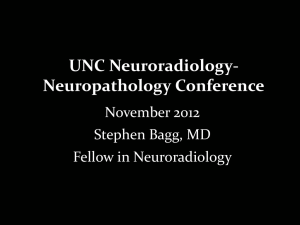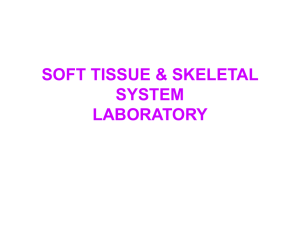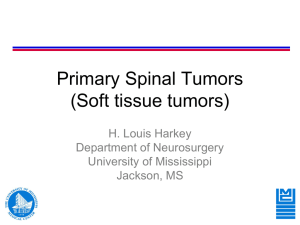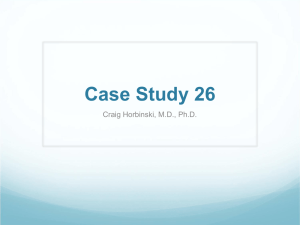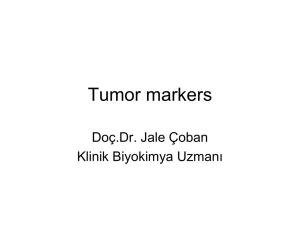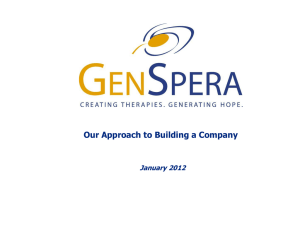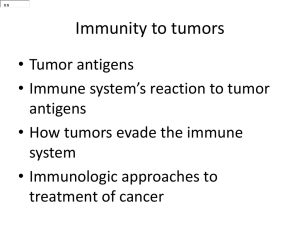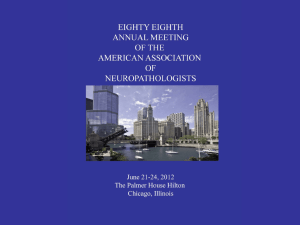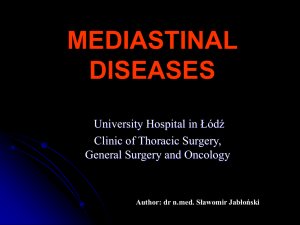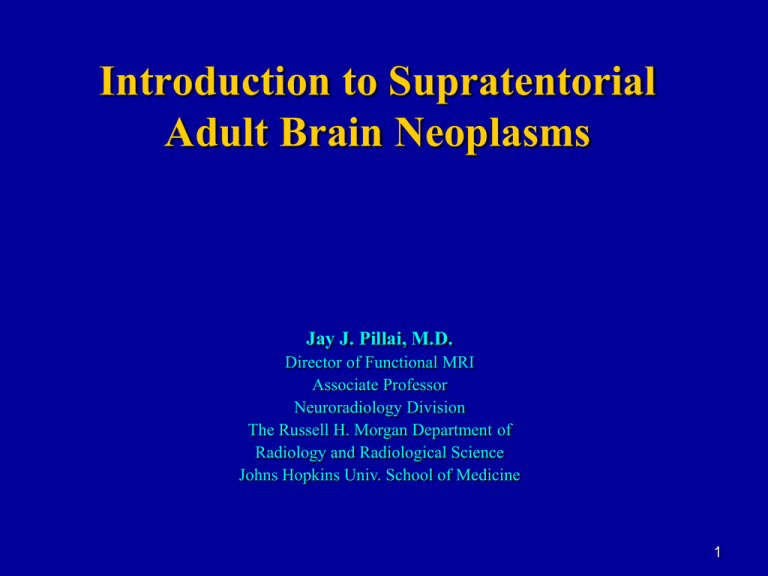
Introduction to Supratentorial
Adult Brain Neoplasms
Jay J. Pillai, M.D.
Director of Functional MRI
Associate Professor
Neuroradiology Division
The Russell H. Morgan Department of
Radiology and Radiological Science
Johns Hopkins Univ. School of Medicine
1
General classification
• Primary Intra-axial Tumors:
• Astrocytic Neuroepithelial tumors
–
–
Diffuse Infiltrative: Fibrillary, anaplastic, GBM, Gliomatosis cerebri
Localized: Pilocytic, PXA, SGCA
• Non-astrocytic Neuroepithelial tumors
–
–
Oligodendroglioma
Ependymal tumors (ependymoma II, subepend I), choroid plexus lesions
• Neuronal / mixed
–
–
Ganglioglioma (gangliocytoma)
DIG, DNET, Central neurocytoma
• Embryonal tumors: PNET, medulloblastoma
• Lymphoma
• Primary Extra-axial tumors:
• Tumors of the meninges
–
–
–
Tumors of meningothelial cells: meningioma
Mesenchymal non-meningothelial tumors: sarcomas, MFH, lipomas, hemangioma
Primary melanocytic tumors: melanocytoma, melanoma
• Neurogenic tumors
–
Neurofibromas, schwannomas
• Metastases
Gliomas
•
•
•
•
•
Astrocytomas
Oligodendrogliomas
Ependymomas
Choroid plexus tumors
(mixed gliomas – oligoastrocytomas)
Astrocytomas
•
•
•
•
Cell of origin: Astrocytes
Most common CNS malignancy
75% of the neuroepithelial tumors
Grades:
– Low grade: Gr I & II (circumscribed vs. diffuse)
– High grade: Gr III & IV (anaplastic vs glioblastoma)
Astrocytic tumors
• Pilocytic Astrocytoma – low grade (WHO Gr I)
•
•
•
•
•
•
– Cyst with a mural nodule – cerebellar (juvenile), hypothalamicchiasmatic, thalamic
Diffuse / Fibrillary Astrocytoma – (WHO Gr II)
– 1/3 FL, 1/3 TL; gemistocytic astro more aggressive than fibrillary,
80% conv to GB, excl supratent
Anaplastic Astrocytoma (Gr III)--may prog to GB in 2yr
Glioblastoma (Multiforme) (Gr IV)--m.c. astro (50-60% of astro, 15%
of ic tumors)
Subependymal Giant Cell Astrocytoma (Gr I)--TS
Pleomorphic xanthoastrocytoma (Gr II)
Gliomatosis cerebri
WHO Grade II Astrocytoma
Diffuse / Low grade astrocytoma
• Focal or diffuse enhancing white matter mass
• Supratentorial – commonly frontal or temporal in location, rare in occipital
•
•
•
•
•
lobe
Infratentorial – typically brainstem glioma
Appear circumscribed on imaging (not at surgery)
Low attenuation on CT wo enhanc
Calcification and necrosis are rare
May mimic subacute infarct on CT, but MRI is definitive
6
High Grade Gliomas
• Highly vascular tumors with areas of necrosis and breakdown of the
•
•
•
•
•
blood-brain barrier
Significantly worse prognosis
Tendency for recurrence
TYPES:
Anaplastic Astrocytoma (WHO Grade III)
Glioblastoma [multiforme] (WHO Grade IV)
7
Anaplastic Astrocytoma
• WHO grade III Astrocytoma
• Infiltrating hemispheric mass with variable enhancement, commonly
•
•
•
•
affecting white matter and located in the frontal and temporal lobes.
Brainstem or thalamic locations in children
Ill-defined margins with edema and mass effect.
Calcification, hemorrhage and necrosis are rare.
Enhancement – patchy or focal, sometimes none.
8
Glioblastoma
• 15-20% of all tumors – ~50% of astrocytomas
• Frontal > temporal > parietal lobes
• Primary GBM or secondary (dedifferentiated) GBM—prim w worse
•
•
•
•
•
prognosis, sec in younger pts w longer clin course
Imaging : Typically is a mass that shows a thick irregular enhancing
rim around a necrotic core with moderate vasogenic edema
Butterfly configuration (extending across the CC)
Multifocal or Multicentric (even wo NF1)
Tendency to CSF spread/drop mets/subarachnoid & subependymal
seeding
Rare variant—gliosarcoma (poor prog, all supratent)
Glioblastoma
• 15-20% of all tumors – ~50% of astrocytomas
• Frontal > temporal > parietal lobes
• Primary GBM or secondary (dedifferentiated) GBM—prim w worse
•
•
•
•
•
prognosis, sec in younger pts w longer clin course
Imaging : Typically is a mass that shows a thick irregular enhancing
rim around a necrotic core with moderate vasogenic edema
Butterfly configuration (extending across the CC)
Multifocal or Multicentric (even wo NF1)
Tendency to CSF spread/drop mets/subarachnoid & subependymal
seeding
Rare variant—gliosarcoma (poor prog, all supratent)
Value of perfusion imaging in evaluation of
biological behavior of gliomas even when findings are not
consistent with initial histopathologic and standard MR imaging
• Law M, Oh S, Johnson G, Babb JS, Zagzag D, Golfinos J, Kelly PJ.
Perfusion magnetic resonance imaging predicts patient outcome as an
adjunct to histopathology: a second reference standard in the surgical and
nonsurgical treatment of low-grade gliomas. Neurosurgery. 2006
Jun;58(6):1099-107; discussion 1099-107.
• Danchaivijitr N, Waldman AD, Tozer DJ, Benton CE, Brasil Caseiras G,
Tofts PS, Rees JH, Jäger HR. Low-grade gliomas: do changes in rCBV
measurements at longitudinal perfusion-weighted MR imaging predict
malignant transformation? Radiology. 2008 Apr;247(1):170-8.
11
Treatment of GBM
Standard treatment: complete resection of CE tumor followed by chemoradiation
(External Beam RT + temozolomide)
--direct placement of chemotherapeutic agents into resection cavity
(carmustine[BCNU] wafers—Gliadel ) or convection-enhanced delivery –
intracerebral drug delivery via small intracranial catheters w pressure gradient to
control infusion rates
Newer experimental therapies:
1) Therapy targeting cancer stem cells
2) Antiangiogenic therapy (bevacizumab [targets VEGF-A], cediranib
[targets VEGFR1-3, PDGFR-beta, c-Kit proto-oncogene], etc.)
3) Immunotherapy (IL4-P38KDEL, IL13-PE8QQR)—interleukins;
natural toxins can be conjugated to drugs that bind to receptors overexpressed by
certain tumor cells
Lima FR, Kahn SA, Soletti RC, et al. Glioblastoma: Therapeutic challenges, what lies ahead. Biochim Biophys Acta
2012; 1826 (12): 338-49.
12
13
Pseudoeffects:
Pseudoprogression & Pseudoresponse
• There is a lot of interest and some recent literature on the subject of
pseudo-effects following treatment of glioblastoma. In practice, often it
comes down to obtaining a follow up MR to see how findings change
longitudinally.
• RANO criteria has replaced older McDonald (2D meas—sum of products
of perpend diam/25% incr CE for prog) and RECIST (1 D meas) criteria
for assessment of treatment response. New RECIST + F criteria
(considering maximum diameter of both CE and T2/FLAIR regions—takes
into account pseudoresponse just as RANO criteria do) also proposed, but
currently RANO criteria are most widely accepted.
Pseudoprogression in Glioblastomas
Quant and Wen. RANO. Curr Oncol Rep (2011) 13:50–56
• Pseudo-progression: An increase in contrast enhancement and/or edema on MRI
without true tumor progression.
• May occur post XRT alone, but enhanced by the addition of temozolomide to
radiotherapy (chemoradiation), particularly in GBM patients with methylated
MGMT.
• Can occur in 40-50% pts on chemoradiation
• In half of patients, the increased CE w/wo increased edema eventually subsides
despite continuing temozolomide, suggesting that the CE reflects transiently
increased permeability of the tumor vasculature from irradiation.
• In some cases may progress to actual radiation necrosis, but if patient is
asymptomatic, then may continue treatment.
• Critical to be aware to avoid premature discontinuation of an effective therapy
based on apparently worsening MRI findings alone.
15
Pseudoresponse in GBMs
Quant and Wen. RANO. Curr Oncol Rep (2011) 13:50–56
• Pseudo-response: decrease in enhancement on MRI without a true anti-tumor
effect
• High permeability of HGG vasculature responsible for CE and peritumoral edema.
• Anti-angiogenic agents targeting VEGF pathway, such as bevacizumab or
cediranib, significantly reduce vascular permeability >>>high apparent radiologic
response rates of 25% to 60% in GBM. Bevacizumab (Avastin ®), is a monoclonal
antibody targeting VEGF.
• Partly due to normalization of tumor vessel permeability resulting in decreased CE,
not necessarily true anti-glioma effect.
• Progression of disease while on VEGF inhibitors results in more treatmentrefractory invasive nature of GBM w much worse prog—frequently seen
expanding T2/FLAIR abnormality despite reduced CE, with rebound phenomenon
wrt edema after discontin of Avastin ( similar to corticosteroids).
16
Agreement among the 4
methods was high (kappa
statistic >0.75) for both
determination of response and
type of progression.
17
RANO Criteria--GBM
Quant EC, Wen PY. Response Assessment in Neuro-Oncology. Curr Oncol Rep 2011; 13:50–56.
18
19
RANO Surgery Task Force Recommendations:
Vogelbaum MA, Jost S, Aghi MK, et al., Application of novel response/progression measures for surgically
delivered therapies for gliomas: Response Assessment in Neuro-Oncology (RANO) Working Group.
Neurosurgery 2012; 70(1): 234-243; discussion 243-4.
20
RANO group proposed changes in
terminology
• Complete Resection of Enhancing Tumor (CRET) and Complete Resection
of Detectable Tumor (CRDT) to replace ‘GTR’
• Partial Resection of Enhancing Tumor (PRET) and Partial Resection of
Detectable Tumor (PRDT) to replace ‘Subtotal Resection’ or ‘Partial
Resection’
• Takes into account currently available imaging technology & info needed
for current clinical trials
Vogelbaum MA, Jost S, Aghi MK, et al., Application of novel response/progression measures for surgically
delivered therapies for gliomas: Response Assessment in Neuro-Oncology (RANO) Working Group.
Neurosurgery 2012; 70(1): 234-243; discussion 243-4.
21
New RANO criteria for LGG
22
New RANO criteria---LGG
Van den Bent MJ, Wefel JS, Schiff D et al., Response
assessment in neuro-oncology (a report of the RANO
group): assessment of outcome in trials of diffuse lowgrade gliomas. Lancet Oncol 2011; 12(6):583—593.
23
Non Astrocytic Neuroepithelial tumors
• Oligodendrogliomas
– Low grade (WHO grade II)
– High Grade or Anaplastic (WHO grade III)
• Neuronal tumors – Ganglioglioma
• Ependymal Tumors
– Subependymoma
– Ependymoma
• Choroid Plexus tumors
– Papilloma and carcinoma
24
Oligodendrogliomas
• 4-5th decade of life—mean age 35 y.o., sz, HA, half low grade
• Slow growing tumors that typically involve the cortex and subcortical
•
•
•
•
•
•
•
white matter—can cause scalloping of inner table
Calcifications in a large number ( ~ 80%)
Enhancement may be mild or none
Frontal lobe more common other lobes, rare in posterior fossa or spine.
Mixed forms and high grade forms common
Typically heterogeneous in signal intensity, frequently with cystic
components, possibly hemorrhage
1p 19q co-deletion or LOH (loss of heterozygosity), i.e., combined allelic
loss of chr arms 1p and 19q ---predictor of both chemosensitivity and
prolonged overall and recurrence-free survival.
10q LOH (correlated with anaplastic grade), however, predicted a survival
disadvantage.
Ramirez C, Bowman C, Maurage C-A, Dubois F, Blond S, Porchet N, Escande F. Loss of 1p, 19w, and 10q heterozygosity
prospectively predicts prognosis of oligodendroglial tumors---towards individualized tumor treatment? Neuro-Oncology
2010; 12(5):490-499
Neuronal and mixed neuronal-glial
tumors
• Gangliocytoma (cerebellar – LD disease)--no risk of
malignant degen; cerebral ctx or cbl; hyper NCCT w minim or no enhanc; iso T1,
T2, hyper FLAIR
• Ganglioglioma (anaplastic ganglioglioma)--peds & young
adults<30, m.c. mixed tumors;slow growth w bony remodel; sz;85% TL>FL, ant 3rd
vent, cbl, cord, o.n.; cystic in 30-50%;1/3 calcif; 50% faint enhanc; cysts m.c. in
younger [<10y.o.];mural nodule poss; may dediff into anaplastic ganglioglioma
• Desmoplastic Infantile Ganglioglioma--1 2 yrs
• DNET-WHO gr I;TL(50-60%)>FL(30%);simil to ganglioglioma;2
st
nd,3rd
dec w
sz; mult cysts, T2 hyper, enh <1/3 unlike DIG, no edema,may scallop inner table,
septations poss, hypodense on CT, a/w FCD in >50%, rarely recur, may arise from
septum pelluc, rarely infratent
• Central neurocytoma--calcif, may be cystic, lat or 3
rd
v, often attached
to septum pellucidum, peak in 3rd decade, mean 29 y.o., mild to mod enhanc, flow
voids---ddx intrav oligo


